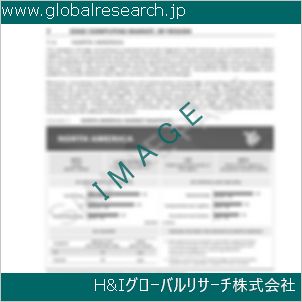Table of Contents
1 Industry Overview of Magnesiumnitrate
1.1 Definition and Specifications of Magnesiumnitrate
1.1.1 Definition of Magnesiumnitrate
1.1.2 Specifications of Magnesiumnitrate
1.2 Classification of Magnesiumnitrate
1.3 Applications of Magnesiumnitrate
1.3.1 Nuclear Application
1.3.2 Non-Nuclear Application
1.4 Industry Chain Structure of Magnesiumnitrate
1.5 Industry Overview and Major Regions Status of Magnesiumnitrate
1.5.1 Industry Overview of Magnesiumnitrate
1.5.2 Global Major Regions Status of Magnesiumnitrate
1.6 Industry Policy Analysis of Magnesiumnitrate
1.7 Industry News Analysis of Magnesiumnitrate
2 Manufacturing Cost Structure Analysis of Magnesiumnitrate
2.1 Raw Material Suppliers and Price Analysis of Magnesiumnitrate
2.2 Equipment Suppliers and Price Analysis of Magnesiumnitrate
2.3 Labor Cost Analysis of Magnesiumnitrate
2.4 Other Costs Analysis of Magnesiumnitrate
2.5 Manufacturing Cost Structure Analysis of Magnesiumnitrate
2.6 Manufacturing Process Analysis of Magnesiumnitrate
3 Technical Data and Manufacturing Plants Analysis of Magnesiumnitrate
3.1 Capacity and Commercial Production Date of Global Magnesiumnitrate Major Manufacturers in 2023
3.2 Manufacturing Plants Distribution of Global Magnesiumnitrate Major Manufacturers in 2023
3.3 R&D Status and Technology Source of Global Magnesiumnitrate Major Manufacturers in 2023
3.4 Raw Materials Sources Analysis of Global Magnesiumnitrate Major Manufacturers in 2023
4 Capacity, Production and Revenue Analysis of Magnesiumnitrate by Regions, Types and Manufacturers
4.1 Global Capacity, Production and Revenue of Magnesiumnitrate by Regions 2019-2024
4.2 Global and Major Regions Capacity, Production, Revenue and Growth Rate of Magnesiumnitrate 2019-2024
4.3 Global Capacity, Production and Revenue of Magnesiumnitrate by Types 2019-2024
4.4 Global Capacity, Production and Revenue of Magnesiumnitrate by Manufacturers 2019-2024
5 Price, Cost, Gross and Gross Margin Analysis of Magnesiumnitrate by Regions, Types and Manufacturers
5.1 Price, Cost, Gross and Gross Margin Analysis of Magnesiumnitrate by Regions 2019-2024
5.2 Price, Cost, Gross and Gross Margin Analysis of Magnesiumnitrate by Types 2019-2024
5.3 Price, Cost, Gross and Gross Margin Analysis of Magnesiumnitrate by Manufacturers 2019-2024
6 Consumption Volume, Consumption Value and Sale Price Analysis of Magnesiumnitrate by Regions, Types and Applications
6.1 Global Consumption Volume and Consumption Value of Magnesiumnitrate by Regions 2019-2024
6.2 Global and Major Regions Consumption Volume, Consumption Value and Growth Rate of Magnesiumnitrate 2019-2024
6.3 Global Consumption Volume and Consumption Value of Magnesiumnitrate by Types 2019-2024
6.4 Global Consumption Volume and Consumption Value of Magnesiumnitrate by Applications 2019-2024
6.5 Sale Price of Magnesiumnitrate by Regions 2019-2024
6.6 Sale Price of Magnesiumnitrate by Types 2019-2024
6.7 Sale Price of Magnesiumnitrate by Applications 2019-2024
6.8 Market Share Analysis of Magnesiumnitrate by Different Sale Price Levels
7 Supply, Import, Export and Consumption Analysis of Magnesiumnitrate
7.1 Supply, Consumption and Gap of Magnesiumnitrate 2019-2024
7.2 Global Capacity, Production, Price, Cost, Revenue, Supply, Import, Export and Consumption of Magnesiumnitrate 2019-2024
7.3 USA Capacity, Production, Price, Cost, Revenue, Supply, Import, Export and Consumption of Magnesiumnitrate 2019-2024
7.4 EU Capacity, Production, Price, Cost, Revenue, Supply, Import, Export and Consumption of Magnesiumnitrate 2019-2024
7.5 China Capacity, Production, Price, Cost, Revenue, Supply, Import, Export and Consumption of Magnesiumnitrate 2019-2024
7.6 Japan Capacity, Production, Price, Cost, Revenue, Supply, Import, Export and Consumption of Magnesiumnitrate 2019-2024
8 Major Manufacturers Analysis of Magnesiumnitrate
8.1 Manufacturer One
8.1.1 Company Profile
8.1.2 Product Picture and Specifications
8.1.2.1 Type I
8.1.2.2 Type II
8.1.2.3 Type III
8.1.3 Capacity, Production, Price, Cost, Gross and Revenue
8.1.4 Contact Information
8.2 Manufacturer Two
8.2.1 Company Profile
8.2.2 Product Picture and Specifications
8.2.2.1 Type I
8.2.2.2 Type II
8.2.2.3 Type III
8.2.3 Capacity, Production, Price, Cost, Gross and Revenue
8.2.4 Contact Information
8.3 Manufacturer Three
8.3.1 Company Profile
8.3.2 Product Picture and Specifications
8.3.2.1 Type I
8.3.2.2 Type II
8.3.2.3 Type III
8.3.3 Capacity, Production, Price, Cost, Gross and Revenue
8.3.4 Contact Information
8.4 Manufacturer Four
8.4.1 Company Profile
8.4.2 Product Picture and Specifications
8.4.2.1 Type I
8.4.2.2 Type II
8.4.2.3 Type III
8.4.3 Capacity, Production, Price, Cost, Gross and Revenue
8.4.4 Contact Information
8.5 Manufacturer Five
8.5.1 Company Profile
8.5.2 Product Picture and Specifications
8.5.2.1 Type I
8.5.2.2 Type II
8.5.2.3 Type III
8.5.3 Capacity, Production, Price, Cost, Gross and Revenue
8.5.4 Contact Information
…
9 Marketing Trader or Distributor Analysis of Magnesiumnitrate
9.1 Marketing Channels Status of Magnesiumnitrate
9.2 Traders or Distributors with Contact Information of Magnesiumnitrate by Regions
9.3 Ex-work Price, Channel Price and End Buyer Price Analysis of Magnesiumnitrate
9.4 Regional Import, Export and Trade Analysis of Magnesiumnitrate
10 Industry Chain Analysis of Magnesiumnitrate
10.1 Upstream Major Raw Materials Suppliers Analysis of Magnesiumnitrate
10.1.1 Major Raw Materials Suppliers with Contact Information Analysis of Magnesiumnitrate
10.1.2 Major Raw Materials Suppliers with Supply Volume Analysis of Magnesiumnitrate by Regions
10.2 Upstream Major Equipment Suppliers Analysis of Magnesiumnitrate
10.2.1 Major Equipment Suppliers with Contact Information Analysis of Magnesiumnitrate
10.2.2 Major Equipment Suppliers with Product Pictures Analysis of Magnesiumnitrate by Regions
10.3 Downstream Major Consumers Analysis of Magnesiumnitrate
10.3.1 Major Consumers with Contact Information Analysis of Magnesiumnitrate
10.3.2 Major Consumers with Consumption Volume Analysis of Magnesiumnitrate by Regions
10.4 Supply Chain Relationship Analysis of Magnesiumnitrate
11 Development Trend of Analysis of Magnesiumnitrate
11.1 Capacity, Production and Revenue Forecast of Magnesiumnitrate by Regions and Types
11.1.1 Global Capacity, Production and Revenue of Magnesiumnitrate by Regions 2024-2029
11.1.2 Global and Major Regions Capacity, Production, Revenue and Growth Rate of Magnesiumnitrate 2024-2029
11.1.3 Global Capacity, Production and Revenue of Magnesiumnitrate by Types 2024-2029
11.2 Consumption Volume and Consumption Value Forecast of Magnesiumnitrate by Regions, Types and Applications
11.2.1 Global Consumption Volume and Consumption Value of Magnesiumnitrate by Regions 2024-2029
11.2.2 Global and Major Regions Consumption Volume, Consumption Value and Growth Rate of Magnesiumnitrate 2024-2029
11.2.3 Global Consumption Volume and Consumption Value of Magnesiumnitrate by Types 2024-2029
11.2.4 Global Consumption Volume and Consumption Value of Magnesiumnitrate by Applications 2024-2029
11.3 Supply, Import, Export and Consumption Forecast of Magnesiumnitrate
11.3.1 Supply, Consumption and Gap of Magnesiumnitrate 2024-2029
11.3.2 Global Capacity, Production, Price, Cost, Revenue, Supply, Import, Export and Consumption of Magnesiumnitrate 2024-2029
11.3.3 USA Capacity, Production, Price, Cost, Revenue, Supply, Import, Export and Consumption of Magnesiumnitrate 2024-2029
11.3.4 EU Capacity, Production, Price, Cost, Revenue, Supply, Import, Export and Consumption of Magnesiumnitrate 2024-2029
11.3.5 China Capacity, Production, Price, Cost, Revenue, Supply, Import, Export and Consumption of Magnesiumnitrate 2024-2029
11.3.6 Japan Capacity, Production, Price, Cost, Revenue, Supply, Import, Export and Consumption of Magnesiumnitrate 2024-2029
12 New Project Investment Feasibility Analysis of Magnesiumnitrate
12.1 New Project SWOT Analysis of Magnesiumnitrate
12.2 New Project Investment Feasibility Analysis of Magnesiumnitrate
13 Conclusion of the Global Magnesiumnitrate (CAS 10377-60-3) Industry 2024 Market Research Report
| ※参考情報 硝酸マグネシウムとは、化学式 Mg(NO₃)₂ で表される無機化合物です。この化合物は、マグネシウム金属と硝酸の反応により得られる塩であり、無色の結晶または白色の粉末として存在します。硝酸マグネシウムは、最も一般的な化合物の一つであり、複数の用途と特徴を持っています。 まず、硝酸マグネシウムの基本的な特徴について説明いたします。この化合物は、水溶性が非常に高く、100gの水に対して約72gの硝酸マグネシウムが溶けることができます。また、温度が上昇するにつれてその溶解度も高まります。さらに、硝酸マグネシウムは、加熱により水分を失って不可逆的に分解し、酸化マグネシウムと二酸化窒素、酸素を生成する特性があります。この特性により、硝酸マグネシウムを扱う際には慎重な温度管理が必要です。 硝酸マグネシウムは、多くの異なる用途に利用されており、特に農業、工業、医療分野で重要な役割を果たしています。農業分野では、マグネシウムは植物の生育に欠かせない必須元素であり、特に光合成の過程において重要です。硝酸マグネシウムは、その高い水溶性により、植物の栄養供給源として利用されることが多く、液肥として施用される例が一般的です。マグネシウムは葉の色を鮮やかに保つ役割もあり、莢果類や葉物野菜に対して特に有効とされています。 工業分野では、硝酸マグネシウムは化学合成の中間体や触媒としても使用されます。さらに、金属の酸洗いや電解過程においても非常に重要な役割を果たします。これにより、工業的には新しい材料の開発や製造プロセスの改善が期待されています。電子材料や特定の用途に特化したガラスの製造にも利用されることがあります。 医療面では、硝酸マグネシウムは医薬品の成分として使用されることがあり、特に心筋梗塞やたばこの依存症に関連する治療に重要です。また、マグネシウムは神経や筋肉の正常な機能を維持するために不可欠な元素であるため、適切なマグネシウムの摂取は健康維持に寄与します。そのため、硝酸マグネシウムは医療用の栄養補助食品としても販売されていることがあります。 さらに、硝酸マグネシウムの種類について触れておきます。硝酸マグネシウムには、無水硝酸マグネシウムおよび六水和物が存在します。無水物は、主に化学合成や工業的な用途に使用され、保存が容易であるため実用的です。一方、六水和物は農業用肥料や水溶性肥料として多く使用される傾向があります。水和物は、土壌中での肥料の放出速度や供給効果が調整されるため、作物の生育に対して非常に有効です。 関連技術の面においては、硝酸マグネシウムの製造過程や利用法において、環境への配慮が重要視されています。アグリビジネスにおける施肥技術の進展、さらには水資源の管理や無農薬栽培の技術などが進められており、これにより硝酸マグネシウムの持続可能な利用が図られています。また、廃棄物からのリサイクル技術や、硝酸マグネシウムの回収技術の進展も注目されています。 このように、硝酸マグネシウムは多方面で利用される重要な化合物であり、農業、工業、医療といった様々な分野で活躍しています。今後も、その応用範囲は拡大し、環境に優しい技術や持続可能な生産方法の発展が期待されるでしょう。 |
❖ 免責事項 ❖
http://www.globalresearch.jp/disclaimer












